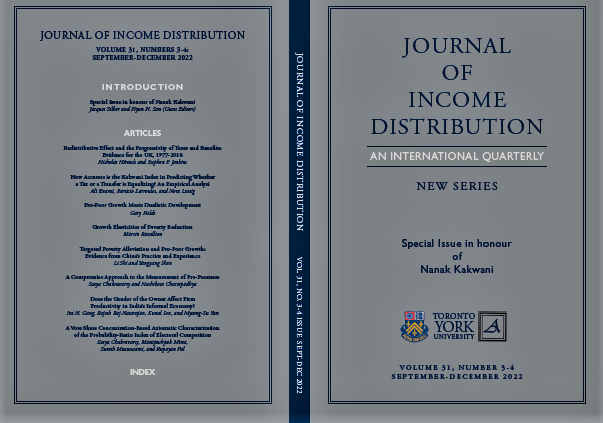A Compromise Approach to the Measurement of Pro-Poorness
DOI:
https://doi.org/10.25071/1874-6322.40547Keywords:
Pro-poorness, inequality, povertyAbstract
A growth vector is often considered as pro-poor if it generates a reduction
in poverty. A second approach to pro-poorness states that growth should
be higher for the poor than for the non-poor. In this article, we develop an
analytical approach by considering a compromise between these two notions
of pro-poorness.
References
Araar, A., J.Y. Duclos, M. Audet, and P. Makdissi 2009 “Testing for pro-poorness of growth, with an application to Mexico”, Review of Income and Wealth 55(4): 853–881.
Atkinson, A.B. 1987 “On the measurement of poverty”, Econometrica 55(4): 749–764.
Blackorby, C., and D. Donaldson 1980 “Ethical indices for the measurement of poverty”, Econometrica 48(4): 1053–1061.
Chakravarty, S.R. 2009 Inequality, polarization and poverty: Advances in distributional analysis New York: Springer.
—–, N. Chattopadhyay and C. D’Ambrosio 2019 “Pro-poorness orderings”, Review of Income and Wealth 65(4): 785–803.
Dhongde, S., and J. Silber 2016 “On Distributional change, pro-poor growth and convergence”, Journal of Economic Inequality 14: 249–267.
Duclos, J.Y. 2009 “What is ‘pro-poor’?”, Social Choice and Welfare 32: 37–58.
Essama-Nssah, B. 2005 “A unified framework for pro-poor growth analysis”, Economic Letters 89(2): 216–221.
—–, and P.J. Lambert 2009 “Measuring pro-poorness: A unifying approach with new results”, Review of Income and Wealth 55(3): 752–778.
Foster, J., and A.F. Shorrocks 1988 “Poverty orderings and welfare dominance.”, Social Choice and Welfare 5(2/3): 179–198.
Grosse, M., K. Harttgen and S. Klasen 2008 “Measuring pro-poor growth in non-income dimensions”, World Development 36(6): 1021–1047.
Jenkins, S., and P.J. Lambert 1997 “Three ‘I’s poverty curves, with an application of UK poverty trends”, Oxford Economic Papers 49(3): 317–327.
Kakwani, N, and E.M. Pernia 2000 “What is pro-poor growth?”, Asian Development Review 18(1): 1–16.
—–, and H.H. Son 2008 “Poverty equivalent growth rate”, Review of Income and Wealth 54(4): 643–655.
Klasen, S. 2008 “Economic growth and poverty reduction: measurement issues using income and non-income indicators”, World Development 36(3): 420–445.
—–, and M. Misselhorn 2008 “Determinants of the growth semi-elasticity of poverty reduction” European Development Research Network Working Paper 11.
Kraay, A. 2006 “When is growth pro-poor? Evidence from a panel of countries”, Journal of Development Economics 80(1): 198–227.
Pernia, E.M. 2003 Pro-poor growth what is it and how is it important? Manila: Asian Development Bank. http://www.adb.org/Documents/EDRC/Policy%5FBriefs/PB017.
Ravallion, M and S. Chen 2003 “Measuring pro-poor growth”, Economic Letters 78(1): 93–99.
Runciman, W.G. 1966 Relative deprivation and social justice. London: Routledge.
Sen, A. 1976 “Poverty: An ordinal approach to measurement”, Econometrica 44(2): 219–231.
Shaked, M. and G. Shanthikumar 2007 Stochastic orders Berlin: Springer.
Son, H.H. 2004 “A note on pro-poor growth”, Economic Letters 82(3): 307–314.
Watts, H.W. 1968 “An economic definition of poverty” in D.P. Moynihan (Ed.) On understanding poverty: Perspectives from the social sciences New York: Basic Books pp. 316–329.
Yitzhaki, S. 1997 “More than a dozen alternative ways of spelling Gini”, Research on Economic Inequality 8: 13–20. DOI:10.1007/978-1-4614-4720-7_2
Zheng, B. 1997 “Aggregate poverty measures”, Journal of Economic Surveys 11(2): 123–162.
—– 2011 “Consistent comparison of pro-poor growth”, Social Choice and Welfare 37: 61–79





